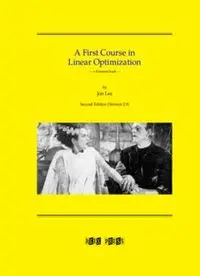
Jon Lee PDF
Preview Jon Lee
A First Course in Linear Optimization —adynamicbook— by Jon Lee SecondEdition(Version2.9) ReEx PrEsS Jon Lee 2013,2014,2015,2016 ReEx PrEsS iii Thisworkislicensedunderthe CreativeCommonsAttribution3.0UnportedLicense (CCBY3.0)cb. Toviewacopyofthislicense,visit http://creativecommons.org/licenses/by/3.0/ where you will see the summary information below and can click through to the full licenseinformation. Go Forward This is a book on linear optimization, written in LATEX. I started it, aiming it at the course IOE 510, a masters-level course at the University of Michigan. Use it as is, or adapt it to your course! It is an ongoing project. It is alive! It can be used, modified (the LATEX source is available) and redistributed as anyone pleases,subjecttothetermsoftheCreativeCommonsAt- tribution 3.0 Unported License (CC BY 3.0) cb. Please take special note that you can (copy and redistribute share inanymediumorformat)and (remix,transform,and adapt builduponforanypurpose,evencommercially)thismate- rial,butyoumustgiveappropriatecredit,providealinkto thelicense,andindicateifchangesweremade. Youmaydo soinanyreasonablemanner,butnotinanywaythatsug- gests that I endorse you or your use. If you are interested inendorsements,speaktomyagent. Istartedthismaterial,butIdon’tcontrolsomuchwhat youdowithit. Controlissometimesoverrated—andIamacontrolfreak,soIshould know! Ihopethatyoufindthismaterialuseful. Ifnot,Iamhappytorefundwhatyoupaid tome. JonLee AnnArbor,Michigan startedMarch2013 v Preface Thisbookisatreatmentoflinearoptimizationmeantforstudentswhoarereasonably comfortablewithmatrixalgebra(orwillingtogetcomfortablerapidly). Itis agoalof not minetoteachanyonehowtosolvesmallproblemsbyhand. Mygoalsaretointroduce: (i)themathematicsandalgorithmicsofthesubjectatabeginningmathematicallevel, (ii)algorithmically-awaremodelingtechniques,and(iii)high-levelcomputationaltools forstudyinganddevelopingoptimizationalgorithms(inparticular,MATLABandAMPL). Proofs are given when they are important in understanding the algorithmics. I make free use of the inverse of a matrix. But it should be understood, for example, that B−1b is meant as a mathematical expression for the solution of the square linear system of equations Bx = b . I am not in any way suggesting that an efficient way to calculate the solution of a large (often sparse) linear system is to calculate an inverse! Also, I avoid the dual simplex algorithm (e.g., rather deftly in describing branch-and- bound), preferring to just think about the ordinary simplex algorithm applied to the dual problem. Again, my goal is not to describe the most efficient way to do matrix algebra! Illustrationsarewoefullyfew. ThoughifLagrangecouldnotbebothered1,whoam I to aim higher? Still, some of the algorithms are in the modern way, with illustrated computercode. The material that I present was mostly well known by the 1960’s. As a student at Cornellinthelate70’sandearly80’s,Ilearnedandgotexcitedaboutlinearoptimiza- tion from Bob Bland, Les Trotter and Lou Billera, using [1] and [3]. The present book isatreatmentofsomeofthatmaterial,withadditionalmaterialoninteger-linearopti- mization,mostlywhichIoriginallylearnedfromGeorgeNemhauserandLes. Thereis nothing here on interior-point algorithms and the ellipsoid algorithm; don’t tell Mike Todd! JonLee AnnArbor,Michigan startedMarch2013 (ormaybereallyinIthaca,NYin1979) vii
